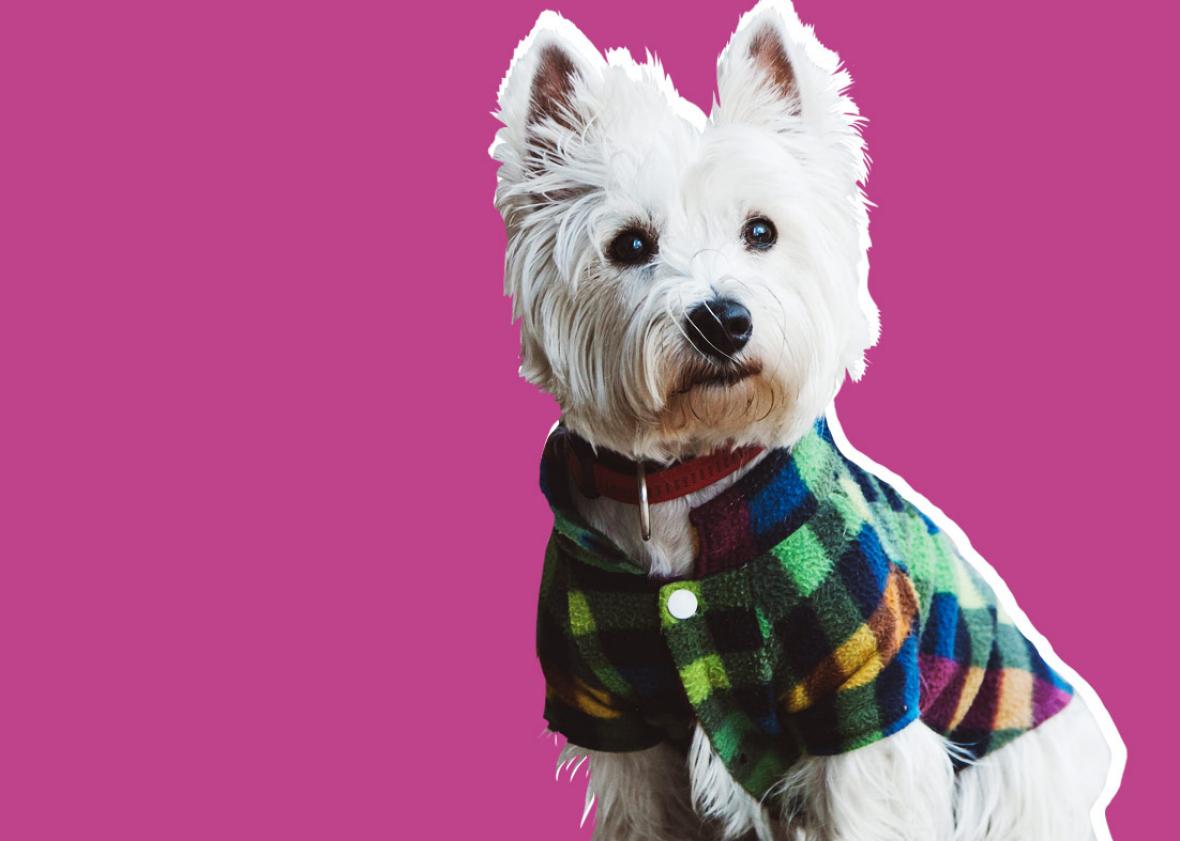Walking through New York City in December is an unparalleled sensory experience—holiday lights, patches of yellow snow, pop-up Christmas tree stands. This week, walking uptown, I eyed a broad-chested pit bull; he was wearing a scarf. Muscles rippling, he confidently navigated the patches of ice before him, evidently unaware of the ridiculous fringed, gray garment his owner had wrapped around his neck. On that same block, I’ve seen dogs decked out in glossy down jackets, yellow fisherman’s rain jackets with matching booties, and even cowl-neck cardigans.
Clearly, these particular choices were influenced by aesthetics and made possible by disposable income, but many dog owners argue that these clothing items aren’t just fun—they’re paramount to their pets’ health. This is strange to consider, given we’re talking about an animal. Unless they spontaneously grew thumbs, dogs could never make clothing on their own, so how could it be essential? It’s even weirder when you remember dogs are descended from the mighty wolf, which can withstand an enormous range in temperature, thriving in arctic conditions as low as -70 degrees and in the desert, enduring weather as high as 120 degrees Fahrenheit. It’s hard to imagine, say, the direwolves in Game of Thrones ever trouncing around in medically necessary suits.
Hard to imagine, sure. But to scientifically investigate the answer to this question, let’s remember that somewhere between 10,000 and 30,000 years ago, humans domesticated the wild wolf, probably by paying them for their loyalty with scraps of food. Over time, wolves became softer creatures—and eventually man’s best friend. But it came at an enormous cost: Those strong, resilient proto-pups evolved, by the power of human selection, into the cute, cuddly, and relatively wimpy things they are today. After millennia of manipulation, that one wolf has been transformed into more than 300 distinct dog breeds. Some, like the dignified Siberian husky or the lovable Samoyed still thrive in cold environments, thanks to their thick, plentiful fur. But others, like Chinese cresteds, are basically naked, having likely been bred from the African hairless dog into the even more fragile and strangely coiffed creatures we know today. Even those dogs that sit (good boy!) in the middle struggle to endue extremes; their short- or medium-length coats are perfectly suited for the more middling climates their owners put them in.
Though dogs are widely varied in their appearance, their body temperature is strikingly similar: The American Kennel Club says dogs range from 101 to 102.5 degrees Fahrenheit. Of course, keeping a Siberian husky and a Chinese crested in that small sweet spot just of slightly more than 100 degrees is hard. Unless you still live in the Arctic Circle, huskies need little things like extra water and bigger things like air conditioning to get them through the summer. Conversely, Chinese cresteds likely wouldn’t survive a winter in the wild. Most dogs should be safe in temperatures above freezing, at least for the duration of a short walk. But, in temperatures below 32 degrees Fahrenheit, things get a little riskier. Huskies may still feel fine, but a small or thinly coated dog could potentially get hypothermia or frostbite, especially if they get wet or spend hours out in the cold. While most dogs are probably OK for a short wintertime walk, the situation is serious enough that experts really do recommend bundling up certain pups before taking them out in that winter wonderland.
Certain breeds clearly could benefit from a well-wrapped scarf or, if you must, a merino wool doggy cardigan. And even though watching the descendant of a woodland wolf walk around with a plastic barrier between his paws and the sidewalk is painful, doggie boots have a purpose too. In cities that salt their roads and sidewalks in the winter, it’s actually important: Road melt chemicals in industrial salts can be toxic to dogs and can also dry out or burn their paws. If you live in a city that uses this kind of salt, it’s possible that your dog will go home to groom, only to ingest the potentially dangerous salts stuck to their body as they clean. It doesn’t guarantee illness, but it’s a risk many dog owners don’t want to take.
I’m still skeptical of many dogs’ fancy cold weather wear, but I have to admit that the evidence supports cautious dog owners in their decision to shield man’s more delicate sidekicks from the ravages of winter. Still, looking at the dogs of New York City, I can’t help but consider what we’ve done to these creatures. Before humans bred them into strange shapes and sizes and stuffed them in tiny outfits, dogs were independent, self-sufficient, and even fearsome creatures. Now, they’re just fashionable furballs.
